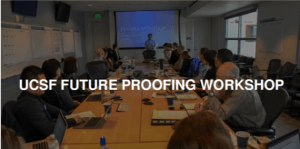Partnering to Deliver a Future Proofing Workshop

We already know that transportation network companies (TNCs) are shaping our mobility choices and behavior in all kinds of ways…perhaps you’ve read about how people are increasingly substituting pricey ambulance rides with TNCs…which got us thinking about the myriad ways that medical institutions are already being impacted by emerging technologies and how the advent of autonomous vehicles (AVs) might further impact them. How does a medical institution, a transportation microcosm of both people and goods movement, plan for the future in the face of disruptive technologies? That’s the question that a recent ‘Future Proofing’ workshop for staff at the University of California, San Francisco (UCSF), a premier medical, teaching, and research institution, attempted to address. Urbanism Next’s Becky Steckler partnered with the transportation planning and engineering firm Fehr & Peers on the workshop to assess the implications of current transportation trends on UCSF in 2035 assuming a reasonable range of AV fleet adoption, and to identify the most problematic potential effects/outcomes UCSF wants to avoid.
The workshop sought to educate UCSF staff on the current state of emerging technologies, including TNCs, AVs, and autonomous delivery technologies, and provide them with an opportunity to rank potential implications as well as identify gaps. The primary focus of the workshop was the impact that these disruptive mobility trends will have on the practices at UCSF. (It is worth noting Fehr & Peers has developed a nifty tool that approximates the relative magnitude of the effect of these trends on vehicle trips, parking demand and curbspace demand, based on different AV adoption scenarios. Check out a snapshot below of the results for one of the scenarios that UCSF tested and/or learn more about the effects of autonomous vehicles on their webpage here).

Here’s what the workshop participants identified as key implications of emerging technologies on UCSF’s future planning efforts:
- Plan for decreased parking demand
- Plan for increased passenger loading demand
- Rethink the function of certain streets
- Explore opportunities to further centralize delivery processes off-campus
- Consider the need for new infrastructure to support emerging delivery technologies
- Understand how the long adoption periods of AV technology will affect campus planning
- Acknowledge importance of partnerships with diverse groups in preparing for technology and policy changes
- Consider and develop UCSF’s position on city, state and federal regulations with respect to emerging technologies
As you can imagine, these are all BIG issues and we’re all still trying to figure out what the solutions should be. However, it is important to acknowledge and commend UCSF for recognizing the need to “future proof.” If we’re planning cities, or even our hospitals, for the ways thing look today then we are already behind.



